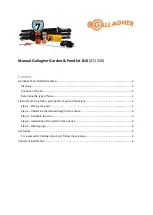
18
Subject to change without notice
External triggering
This trigger mode may be selected with SOURCE
18
>
Extern.
The readout will display Tr:ext. AUXILIARY INPUT
33
will be the
input for the external trigger signal, all internal trigger sources
will be disconnected. In this mode the trigger point symbol (level
and time position) will not be displayed, only the trigger time
position will be indicated. External triggering requires a signal
of 0.3 to 3 V
PP
, synchronous with the vertical input signal(s).
Triggering will also be possible within limits with multiples or
fractions of the vertical input signal frequency. As the trigger
signal may have any polarity, it may happen that the vertical
input signal will start with a negative slope in spite of having
selected positive slope; slope selection refers now to the ex-
ternal trigger.
Indication of triggered operation (TRIG’D LED)
Refer item
19
in ”Controls and Readout“. The LED labelled
TRIG’D indicates triggered operation provided:
– Suffi cient amplitude of the internal or external trigger sig-
nal.
– The trigger point symbol is not above or below the signal.
If these conditions are met the trigger comparator will output
triggers to start the time base and to turn on the trigger indi-
cation. The trigger indicator is helpful for setting the trigger
up, especially with low frequency signals (use normal trigger)
and very short pulses.
The trigger indication will store and display triggers for 100 ms.
With signals of very low rep rate the indicator will fl ash accor-
dingly. If more than one signal period is shown on the screen
the indicator will fl ash each period.
Hold Off time adjustment
Consult ”Controls and Readout“ HOR VAR
26
>
Hold off time
for specifi c information.
After the time base has defl ected the trace from left to right,
the trace will be blanked so the retrace is invisible. The next
sweep will, however, not immediately start. Time is required
to perform internal switching, so the next start is delayed for
the so called hold off time, irrespective of the presence of
triggers. The hold off time can be extended from its minimum
by a factor of 10:1. Manipulation of the hold off time and thus
of the time for a complete sweep period from start to start can
be useful e.g. when data packets are to be displayed. It may
seem that such signals can not be triggered. The reason is
that the possible start of a new sweep does not coincide with
the start of a data packet, it may start anywhere, even before
a data packet. By varying the hold off time a stable display will
be achieved by setting it just so that the hold off ends before
the start of a data packet. This is also handy with burst signals
or non periodic pulse trains.
A signal may be corrupted by noise or hf interference so a double
display will appear. Sometimes varying the trigger level cannot
prevent the double display but will only affect the apparent time
relationship between two signals. Here the variable hold off time
will help to arrive at a single display.
Sometimes a double display will appear when a pulse signal
contains pulses of slightly differing height requiring delicate
trigger level adjustment. Also here increasing the hold off time
will help.
Whenever the hold off time was increased it should reset to its
minimum for other measurements, otherwise the brightness
will suffer as the sweep rep rate will not be maximum. The
following pictures demonstrate the function of the hold off:
period
heavy parts are displayed
signal
adjusting
HOLD OFF time
sweep
Fig. 1
Fig. 2
Picture 1: Display with minimum hold off time (basic setting).
Double image, no stable display.
Picture 2: By increasing the hold off a stable display is achie-
ved.
Time base B (2
nd
time base), Delaying, Delayed,
Sweep
Consult ”Controls and Readout“ HOR VAR
26
and TIME/DIV.
24
for specifi c information.
As was described in ”Triggering and time base“ a trigger will
start the time base. While waiting for a trigger, after runout of
the hold off time, the trace will remain blanked. A trigger will
cause trace unblanking and the sweep ramp which defl ects
the trace from left to right with the speed set with TIME/DIV.
At the end of the sweep the trace will be blanked again and
reset to the start position. During a sweep the trace will also be
defl ected vertically by the input signal. In fact the input signal
does continuously defl ect the trace vertically, but this will be
only visible during the unblanking time.
Let us assume one period of a signal is displayed at a con-
venient time base setting. Increasing the sweep speed with
TIME/DIV. will expand the display from the start, so that parts
of the signal will disappear from the screen. It is thus possible
to expand the beginning of the signal period and show fi ne
detail, but it is impossible to show such fi ne detail for ”later“
parts of the signal.
The x10 Magnifi er (MAG x10) may be used to expand the display
and the horizontal positioning control can shift any part of the
display into the centre, but the factor of 10 is fi xed.
The solution requires a second time base, called time base B.
In this mode time base A is called the delaying sweep and
time base B the delayed sweep. The signal is fi rst displayed
by TB A alone. Then TB B is also turned on which is the mode
”A intensifi ed by B“. TB B should always be set to a higher sweep
rate than A, thus its sweep duration will be also shorter than
that of A. The TB A sweep sawtooth is compared to a voltage
T r i g g e r i n g a n d t i m e b a s e
















































